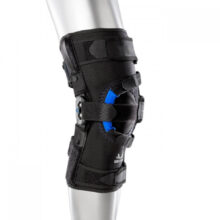Login For Dealer Pricing
Maximum patellofemoral pain relief with SlimLok ROM hinge
The Bio Skin Q Lok ROM aids in the rehabilitation of patellofemoral joint while preventing subluxation and further dislocation during everyday activity. The high-level compression and dynamic patella traction strap make this brace ideal for patients suffering from a high Q angle, chronic pain from patella tilt, glide and malalignment. The thin, ½ inch range-of-motion hinge gives the option of limiting flexion and extension of the knee. Comfort is a key feature of this brace with a combination of Bio Skin’s breathable material and an enhanced single-layer lycra portion that is pre-tensioned to prevent chafing, irritation and bunching behind the knee. This Cirrus™ material also enhances the grip of the traction strap to ensure patellar control.




